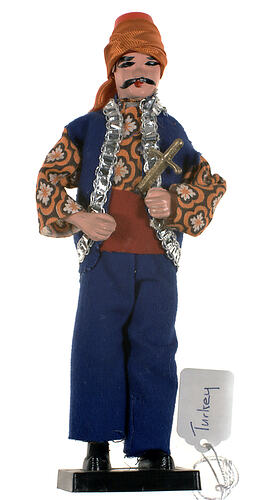Summary
National Doll produced to represent a Turkish man, it was purchased for Monica Gates by her mother in 1978. Türkiye is a diverse blend of many different cultures, including the Oguz, Turkic, Anatolian, Ottoman and Western cultures. The traditional dress of Türkiye has changed slowly over time according to varying cultural influences, which influenced both design and materials. Turkish traditional dress has tribal and village distinctions, and shares features with Central Asian dress, the dress of the Ottoman Court, and Middle Eastern dress.
Turkish traditional dress is characterised by the layering of garments, distinctive decoration on the fabrics, and a geometric cut. Common items are the salvar (baggy trouser), gomlek (chemise), ucetek (three-skirted cloak). Sleeveless vests and waist-length jackets are also common. The layers are held together by a girdle or belt, or by a shawl (sal kusak) that is folded and wrapped around the waist. Elaborate headgear for both men and women is often worn, although both the fez and turban which had both long been associated with Turkish men's dress were banned in 1925 by Turkish President Mustafa Kemal Ataturk as he sought to modernise Türkiye and distance the new Republic from customs and culture associated with the Ottoman Empire.
The Gates collection contains 170 national dolls from 74 different countries and some correspondence relating to the acquisition of several of the dolls. The costumes of the dolls represent national costumes from the 19th Century to the 1990s. Monica Gates collected or was given these dolls between 1957 and 1990.
These dolls were purchased as souvenirs of particular countries and like many mass produced souvenirs they are often not accurate representations of a particular country or region, and may actually better reflect neighbouring counties or regions. This occurs because costumes are often stylised and simplified resulting dolls wearing generic costume elements which are common to many countries/regions. Often the fabrics and decorations used are selected to make the dolls cheap and easy to manufacture and aesthetically pleasing. This can result in the fabrics, colours and decorations of the doll's clothing having little or no reflection of the costume associated with a particular country or region they are meant to be representative of.
Physical Description
Male doll with blue trousers and matching vest. The vest is trimmed with silver. Under the vest is an orange, brown and white shirt. Around the waist is a red wasit-band out of which sticks a gold sword.
More Information
-
Collecting Areas
-
Acquisition Information
Purchase
-
Place & Date Made
-
User
Mrs Monica Gates, Frankston, Greater Melbourne, Victoria, Australia, circa 1976-1990
-
Place Depicted
Türkiye (formerly Turkey)
Doll is intended to represent a man wearing traditional Turkish clothing; which is still common in Turkish villages, although without the ornamentation of this doll's clothing. -
Classification
-
Category
-
Discipline
-
Type of item
-
overall dimensions
5.5 cm (Length), 5 cm (Width), 20 cm (Height)
-
Keywords
Children's Play, Clothing, Cultural Awareness, Cultural Beliefs, Dolls, National Costumes, National Identity, Souvenirs

